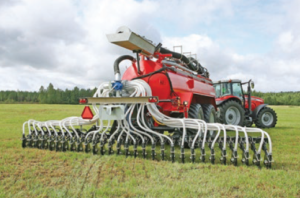The past 12 months have seen fertiliser prices increase by more than 300%. This has led to many farmers looking for alternative nutrient inputs. Many weird and wonderful materials are applied to the land for their fertiliser content – composts, paper crumble, food waste, sewage sludge, seaweed and many others. But the most frequently used, and often the most freely available, is animal muck – more commonly referred to as manures and slurries.
As well as containing valuable nutrients such as nitrogen, phosphorous and potassium, slurries and manures contribute many other benefits when applied to agricultural land. Most important of all, they add to the organic matter fraction of the soil. This is vitally important as it is the organic matter (OM) that supports all the living organisms that dwell between our feet. From bacteria to fungi, millipedes to earthworms and countless others, there is a whole other ecosystem down there, and without this life, the soil would be nothing more than a weathered rock or, quite simply, a desert.
As well as plant nutrients and a food source for soil biology, applications of manures benefit soils by:
- Increasing water holding capacity.
- Reducing pollution of groundwater.
- Improving drainage.
- Reducing soil erosion.
- Making soils easier to cultivate.
All these benefits mean that analysis of slurries, manures and wastes has never been more popular.
The financial value of organic manures is determined by two key factors: –
- The nutrient content of the material.
- The replacement value of an equivalent application of bagged fertiliser.
Slurry and manure analysis measures the total nutrient content of the material and a clear determination of the dry matter content, which is otherwise usually visually estimated.
The values found in the RB209 are an average across a wide range of samples but there is often quite a variation between results. Studying the long-term Lancrop dataset of analysis reveals that this variation can be significant. Whilst overall average values agree well with RB209, when looking at the average of the highest and lowest nutrient content the potential for a large difference becomes apparent.
Efficiency plays a key role when optimising nutrient availability following manure applications. Timing and application method have a huge impact on how much can be utilised by the following crop or grass. For example, for a 6% DM cattle slurry RB209 states that 10% of the total nitrogen applied will become available to the following crop when surface applied in autumn. However, if band spread in the spring this availability increases to 35%. (Source: AHDB RB209 Book 2 Organic Manures – Table 2.9)
By considering all of the above, it is possible to calculate the equivalent fertiliser value of the manure and the economic impact of application timing and method. To maximise the agronomic and financial value of organic materials it is not just the nutrient content that needs to be taken into account but also how and when the material is used.
Organic manures should only be applied to a crop when the crop can use the nutrients, in accordance with The Farming Rules for Water. Find out your crop need by using the free software program MANNER-NPK.
Organic manures (including digestates) should not be applied when:
- The soil is waterlogged, flooded,
frozen or snow-covered. - There’s a significant risk of
run-off to surface water, leaching
to groundwater and run-through
beyond crop use. - During a closed period.
By Hannah Shirt, Lancrop.
For more information and advice maximising fertiliser efficiency and slurry usage, please speak to your NWF Sales Specialist, view our MicroZyme-R Slurry Treatment product or get in touch on 0800 756 2787
